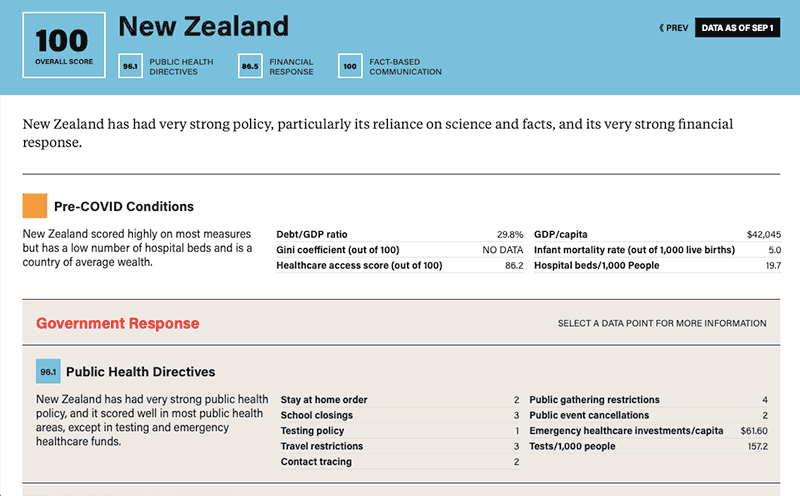Foreign visitors have helped prop up the faltering Italian economy. If they don’t come back, the country is in trouble.
- 62.1 Public Health
Directives - 0 Financial
Response - 100 Fact-Based
Communication
While hit hard by COVID-19, Italy’s reliance on facts and improved contact tracing has helped slow the spread and slightly improved its overall score since January.
Pre-COVID Conditions
Despite a relatively strong overall healthcare system, Italy’s low number of hospital beds likely played a major role in COVID-19’s devastating impact there.
- Debt/GDP ratio 135.5%
- GDP/capita $41,582
- Gini coefficient (out of 100) 35.9
- Infant mortality rate (out of 1,000 live births) 3
- Healthcare access score (out of 100) 88.7
- Hospital beds/1,000 People 24.1
Government Response
Select a data point for more information(Data points represent policy level as of Sep 1.)
Public Health Directives
Italy’s limited testing and low emergency healthcare spending likely played a role in it becoming an epicenter of the pandemic early on, but its strong policy response likely helped the country manage its case spike fairly quickly.
- Stay at home order 0
- Public gathering restrictions 2
- School closings 3
- Public event cancellations 2
- Testing policy 2
- Emergency healthcare investments/capita $122.23
- Travel restrictions 3
- Tests/1,000 people 84.6
- Contact tracing 2
Financial Response
Italy has a very weak score on financial support, driven largely by its low level of income support for workers, which it also implemented fairly late in the crisis.
- Financial stimulus as share of GDP 9.4%
- Income support 1
- Debt forebearance 2
Fact-Based Communication
Italy’s government has not engaged in misinformation or limited press freedom in response to COVID-19.
- Reliance on science/fact based information 0
- Press freedom 0
COVID-19 Status as of Sep 1
Italy’s current status with COVID-19 is relatively strong, with a high death rate balanced by a very low positivity rate, likely due to strong public health policy.
- Total deaths 35,483
- Death rate per 100K 586.9
- Total cases 269,214
- Cases per 100K 4,453
- Percent of positive tests 2.3
- Change in positivity rates +1.3
| Date | Status | New Cases/1M | |
|---|---|---|---|
| 1 | May 18 | Retail, restaurants, and hairdressers reopen | 15.04 |
| 2 | May 25 | Sports facilities reopen | 10.45 |
| 3 | Jun 15 | cinemas and theaters reopened | 4.70 |
| 4 | Aug 17 | Nightclubs close, masks mandated | 7.91 |
Differentiating Factors
- Migrants become targets for right-wing politicians: As COVID-19 numbers climb in Italy, right-wing political leaders are inaccurately blaming migrants for the rise. Read More
- Rising cases amidst relaxed public prompt increased restrictions: With a rise in COVID-19 cases, likely due to an increasingly relaxed populace, Italy closed nightclubs and mandated face masks. Read More
- Strict lockdown succeeds at price of economic health: Italy's tourist industry has maintained its economy through economic downturns and global recessions, but COVID-19's devastating early impact on Italy, and its related travel restrictions, have eliminated this economic safety net, raising questions about Italy's reslience and post-pandemic recovery. Read More
- Working mothers bear brunt of crisis: The government allocated $8.6 billion to support families and businesses during Italy's strict lockdown. Despite this intervention, NGOs are predicting that working women will be the Italians hardest hit by the pandemic. Nearly three quarters of working mothers have continued to work outside the home throughout the pandemic, and 70 percent of those who have contracted COVID-19 at work are female, due to their over-representation in essential work. Read More
- COVID-19 requires new response to migration: Southern Italy remains a popular entry point for migrants crossing the Mediterranean, necessitating new protocols for migrant arrivals. In early July, 180 migrants rescued from the sea were subjected to a two-week quarantine on board a ship docked in Sicily, where NGOs have reported a high incidence of violence and suicide attempts. Read More
Compared with Neighboring/Nearest Countries
-
42.8Switzerland 42,069
Cases 4,861
Per 1M 1,725
DeathsSwitzerland's reliance on facts and an open media drove its score up to the median, helping to counter weak financial support and limited restrictions on social interactions.
-
58.4France 281,025
Cases 4,305
Per 1M 30,635
DeathsFrance maintained its improved public health policy from the early fall, keeping its score relatively strong, although poor contact tracing and a relatively small stimulus package kept it from being higher.
-
47.9Spain 462,858
Cases 10,073
Per 1M 29,152
DeathsSpain's score jumped since January to just over the median, having implemented stricter public health policies, but the country's minimal stimulus support still drags down its overall score.
Further Reading From Foreign Policy
Be the source of actionable insight.
Select one of the subscription options below to read the full Covid-19 Global Response Index. Unlock even more global intelligence with a subscription to FP Insider.
Already an FP Insider? Log In
Looking for group access? Contact us directly

Statistics and government response factors available on each country profile include:
Pre-COVID Conditions:
- Debt to GDP ratio
- Infant mortality rates
- Hospital beds per 1,000 people
- Gini coefficients measuring inequality
- Health access and quality
COVID-19 Public Health Directives:
- Stay-at home orders
- School-closing policy
- Public-gathering restrictions
- Cancellation of public events
- Testing policy and rates per 1,000 people
- Emergency healthcare spending per capita
- Travel restrictions
- Contact tracing
COVID-19 Financial Response:
- Stimulus package as a share of GDP
- Income support
- Debt-forbearance
Public Communications:
- Instances of misinformation by leadership
- Limitations on press freedom, censorship
Current/Historic In-Country COVID-19 Status:
- Death rates per 1 million
- Case rates per 1 million




